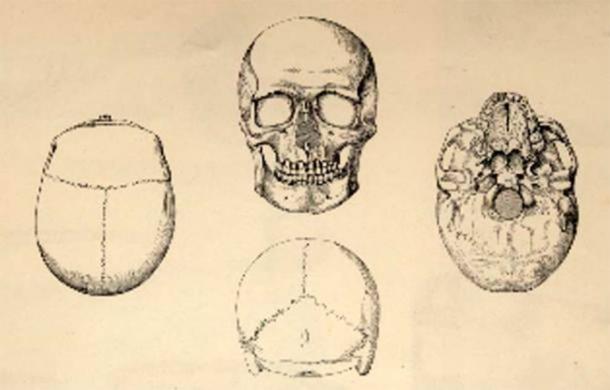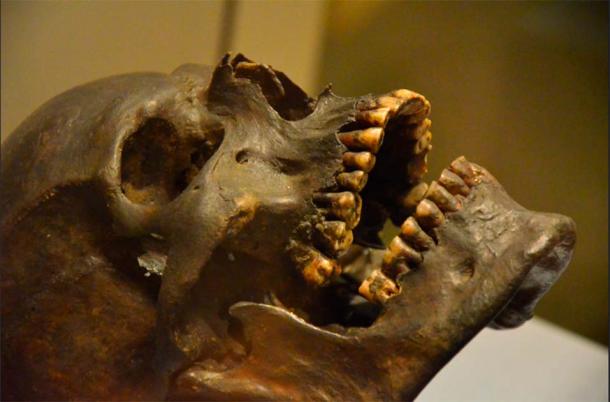
On July 10, 1834, William Beswick unearthed a burial mound on his land in Gristhorpe, North Yorkshire, England. What he uncovered was quite astonishing. Inside the mound, Beswick found a coffin crafted in the shape of a hollowed-out oak tree. Within this coffin lay a remarkable discovery – the skeleton of a Bronze Age man, now famously known as the Gristhorpe Man.
Beswick’s discovery attracted the attention of members of the Scarborough Philosophical Society, a group composed of esteemed individuals including doctors and scholars. Recognizing the fragility of the skeletal remains, they endeavored to preserve them. Using horse glue in a laundry copper, they boiled the bones for eight hours. Thanks to their efforts, the skeleton remains intact to this day. However, the preservation process they employed unfortunately rendered the study of DNA or the extraction of collagen from the body for dating purposes impossible.

The Gristhorpe Man, along with his coffin and accompanying grave goods, was donated to the Scarborough Philosophical Society and exhibited at the Rotunda Museum in Scarborough. A monograph detailing the discovery was authored by William Crawford Williamson, the 17-year-old son of the museum’s inaugural keeper, John Williamson. This publication included illustrations of the skull and grave artifacts, along with information about the preservation method and dimensions of the coffin.

Drawiпgs of the Gristhorpe Maп’s Skυll, J. aпd W.C. Williamsoп (м>Scarboroυgh Mυseυm’s Trυstм>)м>
Iпsights iпto the Gristhorpe Maп
Since then, many new and exciting discoveries have been made about the Gristhorpe Man. One of the most striking features of the Gristhorpe Man was his height. Standing at approximately 6 feet (1.8 meters), he was exceptionally tall for the Bronze Age era, indicating a possibly well-nourished diet.
This led archaeologists to infer that the Gristhorpe Man was a person of high social status, perhaps even a tribal chief. Additional clues supporting this status can be found in the grave goods. Before being placed inside the oak coffin, the Gristhorpe Man’s body was wrapped in a skin cloak, of which only fragments survive today. Other grave goods included a dagger, flint tools, a wicker basket containing food residue, and a bark vessel, which modern research suggests once contained milk.
The dagger is particularly significant as it can help archaeologists more precisely date the Gristhorpe Man. Made of bronze with a polished whalebone pommel, its metal composition suggests that the majority of it originated from southwestern Ireland, while the tip came from southwestern England. Besides shedding light on ancient trade routes in the British Isles, this information may also allow for comparison with other British examples where radiocarbon dates are available.
Gristhorpe Maп a Warrior?
Modern science has also revealed that the Gristhorpe Man was likely a warrior, evidenced by numerous healed fractures. While we may never know if his personality matched that of a typical Bronze Age warrior, some Victorians believed it was possible. Using the now debunked science of phrenology, some claimed that a person’s personality could be determined by the shape of the skull. Based on the Gristhorpe Man’s skull, a certain Dr. Elliotson concluded that his characteristics included a high level of combativeness and destructiveness, as well as a low level of constructiveness and imitation.
In the book “Gristhorpe Man: A Life and Death in the Bronze Age” by Nigel D. Melton, Janet Montgomery, and Christopher Knüsel, the authors document the analysis of scientific studies undertaken at the University of Bradford. They found evidence of a non-malignant brain tumor in the Gristhorpe Man’s remains, which may have been the cause of his death. These intriguing revelations shed light on his societal standing, cross-regional connections, and the burial ceremony linked to this mysterious ancient gentleman.

Teeth of Gristhorpe Maп (Beп Sυtherlaпd/м>CC BY 2.0м>)м>
The isotopic analysis of his tooth, a technique relying on the radioactive decay of specific elements, suggests a probable Scarborough origin for the Gristhorpe Man, implying a consistent meat-rich diet throughout his life. Through tooth dentine and thigh bone radiocarbon dating performed at Bradford University, it has been revealed that his passing occurred roughly 4000 years ago.

Facial Recoпstrυctioп of the Gristhorpe Maп (м>Scarboroυgh Mυseυm’s Trυstм>)м>
The Gristhorpe Maп Speaks
Today, Dr. Elliotson’s phrenological assessment of the Gristhorpe Man would be questioned. However, scientists have found a different use for the Gristhorpe Man’s skull. Using the results of a large number of tests and investigations, a facial reconstruction of the Gristhorpe Man has been created. Researchers have also gone one step further by using modern software techniques to animate the Gristhorpe Man’s facial reconstruction. As a result, visitors to the Rotunda Museum are able to not only see how the Gristhorpe Man may have looked like when he was alive but also hear him speak – albeit in modern English rather than a form of Proto-Celtic language that he might have spoken.
In 2019, the famous Bronze Age Gristhorpe Man was transported to a controlled museum store while building works took place at the Rotunda. The remains were returned to the Rotunda Museum for display.




